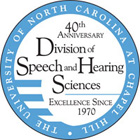Bilingual Language Development
Lisa Domby, MS, Clinical Assistant Professor, Division of Speech & Hearing Sciences, discusses accent modification.
Courtesy of Lisa Domby
Lisa Domby points out that in the Chapel Hill school system there are over 50 different languages represented in the English as a Second Language (ESL) system; students in Durham’s ESL program speak over 100 different languages. When a speech or language disorder is suspected, testing in both languages is necessary before determining whether there is a true language disorder, or simply a need for further ESL instruction. Nationwide, there are very few bilingual speech-language pathologists (SLPs), and is impossible for them to be familiar with all the languages they will encounter in clinical practice. To address this need, Lisa has coordinated an annual Bilingual Conference at UNC for the last five years. The conference targets monolingual SLPs working in early intervention programs and schools, and provides them with specific guidelines and resources for working with culturally and linguistically diverse populations.
Cultural Differences
Some areas of SLP practice are more likely to be affected by cultural differences. For example, SLPs assessing feeding and swallowing need to be aware that the time when children begin to feed themselves varies by culture; in some cultures the parents feed the child longer or allow a bottle longer. There are also dietary preferences and restrictions, so the SLP needs to make sure that assessment tools and food used for testing are appropriate to the culture. Speech and language developmental milestones can also vary among languages.
Phonology
It is important that speech differences not be labeled as disorders. Some sounds of English, such as th, don’t exist in many other languages. It would be natural for a nonnative English speaker to substitute a sound from the native language for one of these sounds, so prior to assessment the SLP needs to learn the inventory of sounds that occur in both languages. The SLP may need to work with an interpreter to develop a list of words containing all the sounds of the child’s native language. A monolingual SLP can accomplish this by using the International Phonetic Alphabet (IPA) to transcribe the words. The SLP then compares the child’s speech with the IPA transcription to determine if there is a speech delay.
To teach her students the variety of speech sounds in different languages, Lisa has them collect sound files of nonnative English speakers reading a paragraph containing most speech sounds of English (see sidebar). The students then transcribe the sound files using the IPA, so they can see and hear the natural variations produced. UNC students are contributing these sound files to the Accent Archive (accent.gmu.edu), a collection of thousands of speech samples from a variety of language backgrounds.
”We need to develop the skills for speech-language pathologists to effectively work with culturally and linguistically diverse populations.”
Assessing Language Delay
SLPs are often asked to determine whether a bilingual child’s delayed acquisition of English is due to a language disorder, or whether the child needs more instruction in English as a Second Language. This is especially difficult when the native language is not commonly encountered in the U.S. For example, there has been a recent influx of refugees from Burma. The assessment may need to be conducted with assistance from an interpreter who speaks the native language. One helpful assessment instrument is the Bilingual Early Language Assessment (BELA). This tool uses early concepts and objects that are familiar to most children, regardless of their cultural background. The items are culturally neutral or universal, such as ball, bus, shoe. This also decreases the likelihood that a language difference will be labeled as a disorder.
Lucia Mendez, a PhD student in the Speech and Hearing Sciences program, is focusing her studies on evidence-based practices in bilingual language development:
“Right now the percentage of bilingual SLPs is very low. There is a great need for these programs in North Carolina and nationwide; the demographics are changing so quickly that we need to pursue bilingual language development research in an active manner.”
Accent Archive – George Mason University: http://accent.gmu.edu
“Please call Stella. Ask her to bring these things with her from the store: Six spoons of fresh snow peas, five thick slabs of blue cheese, and maybe a snack for her brother Bob. We also need a small plastic snake and a big toy frog for the kids. She can scoop these things into three red bags, and we will go meet her Wednesday at the train station.”
-Paragraph from the Accent Archive that is read in English by nonnative speakers and phonetically transcribed to highlight differences


 Global Initiatives
Global Initiatives





